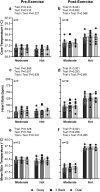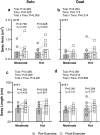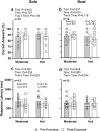Simultaneous assessment of motor and cognitive tasks reveals reductions in working memory performance following exercise in the heat
- PMID: 36339090
- PMCID: PMC9629122
- DOI: 10.1080/23328940.2021.1992239
Simultaneous assessment of motor and cognitive tasks reveals reductions in working memory performance following exercise in the heat
Abstract
This study tested the hypothesis that, following exercise in the heat, motor task performance will be impaired when assessed simultaneously with a cognitive task. In a randomized, crossover and counterbalanced design, twelve healthy adults (23 ± 2 years, 5 women) completed four 10-minute exercise circuits involving upper and lower body exercise in a moderate (18.1 ± 1.7°C, 38 ± 10% relative humidity) and a hot (40.3 ± 1.1°C, 26 ± 5% relative humidity) environment. Experimental testing was completed in a temperate thermal environment before exercise (~25°C) and in either the moderate or hot environment following exercise. The 3 Back test (a test of working memory) was used as the cognitive task and postural sway was used as the motor task. Cognitive and motor task performance assessments were conducted both individually (solo) and simultaneously (dual). At the end of exercise, core temperature (by 0.4 ± 0.3°C, P < 0.001), heart rate (by 12 ± 18 bpm, P = 0.025), and mean skin temperature (by 7.6 ± 0.8°C, P < 0.001) were higher in the Hot trial compared to Moderate. During solo testing, postural sway increased from pre- to post-exercise in the Hot (P ≤ 0.028), but not the Moderate (P ≥ 0.261) trial. During dual testing, postural sway did not differ between trials (P ≥ 0.065) or over time (P ≥ 0.094). During solo testing, 3 Back performance did not differ between trials (P = 0.810) or over time (P = 0.707), but during dual testing 3 Back performance following exercise was reduced in the Hot compared to the Moderate trial (P = 0.028). Simultaneous assessment of motor and cognitive tasks reveals that motor performance is reduced following exercise in the heat. .
Keywords: Cognitive function; exercise; heat stress; hyperthermia; postural sway.
© 2021 Informa UK Limited, trading as Taylor & Francis Group.
Conflict of interest statement
No potential conflict of interest was reported by the author(s).
Figures




References
-
- Daanen HA, van de Vliert E, Huang X.. Driving performance in cold, warm, and thermoneutral environments. Appl Ergon. 2003;34(6):597–602. - PubMed
-
- Froom P, Caine Y, Shochat I, et al. Heat stress and helicopter pilot errors. J Occup Environ Med. 1993;35:720–724. - PubMed
-
- Wyon DP, Wyon I, Norin F. Effects of moderate heat stress on driver vigilance in a moving vehicle. Ergonomics. 1996;39:61–75. - PubMed
-
- Adam-Poupart A, Smargiassi A, Busque M-A, et al. Effect of summer outdoor temperatures on work-related injuries in Quebec (Canada). Occup Environ Med. 2015;72:338–345. - PubMed
-
- Fogleman M, Fakhrzadeh L, and Bernard TE. The relationship between outdoor thermal conditions and acute injury in an aluminum smelter. Int J Indust Ergon. 2005;35:47–55.
LinkOut - more resources
Full Text Sources
